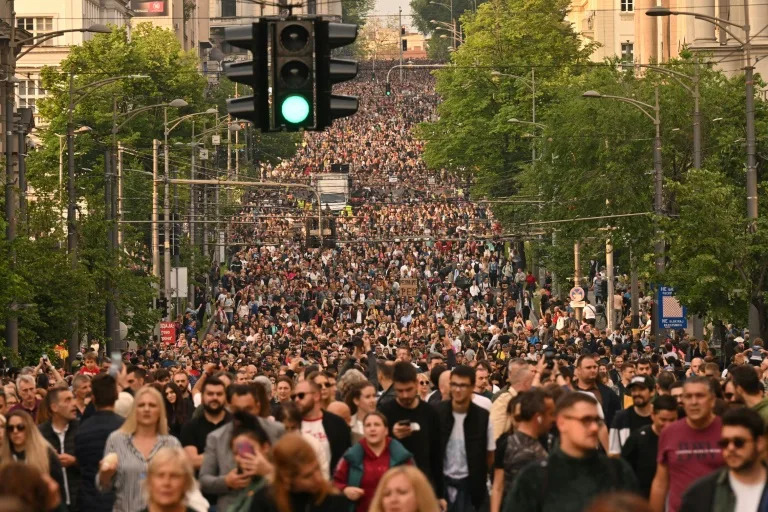What began as an expression of grief after two shootings in Serbia that left 18 people dead has morphed into a mass anti-government movement, with tens of thousands of people taking to the streets and confronting President Aleksandar Vucic.
The “Serbia Against Violence” movement generated some of the largest protests in the country since the demonstrations that led to the fall of former strongman Slobodan Milosevic more than two decades ago.
The marches appear to have found an echo in anger at Vucic and the ruling party for what the protesters call a culture of violence driven by the government and the media it controls.
“Everything is so unhealthy in our society; it’s scary,” Slobodan Markovic, a 70-year-old pensioner, told AFP during a demonstration.
The protests began this month after two shootings in less than 48 hours: the first on May 3 at a Belgrade school, where a 13-year-old teenager shot dead nine classmates and a guard, and the second in two villages near the capital, where a 21-year-old gunned down eight people.
The violence deeply shook the country. Soon after, the first protest took the form of a silent march, calling for the repression of violent content in the pro-government media and the resignation of the Minister of the Interior and the head of intelligence.
The initial shock quickly turned to outrage when the protesters’ demands were rejected by the president and his allies, who mocked the marches and insulted their participants.
Opposition Leaders Disqualified and Parallel Realities: Tensions Rise in Serbia Protests
Vucic has disqualified opposition leaders at the forefront of the protests and compared them to “vultures” and “hyenas” who seek to exploit the tragedy for political purposes.
The president also called for his own demonstration on Friday, which he announced as “the largest gathering in Serbian history.”
Belgrade is bracing for what could be a tense weekend, with thousands of Vucic supporters due to arrive by bus from across the country, while the opposition plans to take to the streets again on Saturday.
“The government seems to be living in a parallel reality. It’s as if it doesn’t see these people, doesn’t hear their cries and doesn’t want to serve them,” commented Dobrica Veselinovic, leader of a leftist opposition party.
Media Manipulation and Ignorance: The Battle for Truth in Serbian Protests
Much of the anger at the protests is aimed at the pro-government media, which they accuse of broadcasting gratuitous violence while providing space for the government to polarize the public and attack its opponents.
Vucic often appears on these channels to attack his rivals with aggressive threats, along with programs glorifying the criminal underworld.
Since the start of the protests, government programs have called protesters “scum,” published altered photos to minimize participation, and accused foreign powers of directing the marches.
Such messaging often finds a receptive audience in rural areas loyal to the president, where there is little access to media outside those sympathetic to the government.
“A large part of Serbia doesn’t even know about the events in Belgrade,” Cedomir Cupic, a political science professor at Belgrade University, told AFP.
The protesters plan in any case to keep up their momentum and generate more pressure on the government.
“I thought there was no hope,” admitted Bozana Vujovic, a 41-year-old economist from Belgrade. “But with this energy, now I think there is.”

